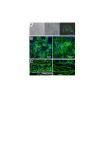Physical developmental cues for the maturation of human pluripotent stem cell-derived cardiomyocytes
- PMID: 25688759
- PMCID: PMC4396914
- DOI: 10.1186/scrt507
Physical developmental cues for the maturation of human pluripotent stem cell-derived cardiomyocytes
Abstract
Human pluripotent stem cell-derived cardiomyocytes (hPSC-CMs) are the most promising source of cardiomyocytes (CMs) for experimental and clinical applications, but their use is largely limited by a structurally and functionally immature phenotype that most closely resembles embryonic or fetal heart cells. The application of physical stimuli to influence hPSC-CMs through mechanical and bioelectrical transduction offers a powerful strategy for promoting more developmentally mature CMs. Here we summarize the major events associated with in vivo heart maturation and structural development. We then review the developmental state of in vitro derived hPSC-CMs, while focusing on physical (electrical and mechanical) stimuli and contributory (metabolic and hypertrophic) factors that are actively involved in structural and functional adaptations of hPSC-CMs. Finally, we highlight areas for possible future investigation that should provide a better understanding of how physical stimuli may promote in vitro development and lead to mechanistic insights. Advances in the use of physical stimuli to promote developmental maturation will be required to overcome current limitations and significantly advance research of hPSC-CMs for cardiac disease modeling, in vitro drug screening, cardiotoxicity analysis and therapeutic applications.
Figures



Similar articles
-
Learn from Your Elders: Developmental Biology Lessons to Guide Maturation of Stem Cell-Derived Cardiomyocytes.Pediatr Cardiol. 2019 Oct;40(7):1367-1387. doi: 10.1007/s00246-019-02165-5. Epub 2019 Aug 6. Pediatr Cardiol. 2019. PMID: 31388700 Free PMC article. Review.
-
Maturation of Cardiomyocytes Derived from Human Pluripotent Stem Cells: Current Strategies and Limitations.Mol Cells. 2018 Jul 31;41(7):613-621. doi: 10.14348/molcells.2018.0143. Epub 2018 Jun 12. Mol Cells. 2018. PMID: 29890820 Free PMC article. Review.
-
MicroRNA-mediated maturation of human pluripotent stem cell-derived cardiomyocytes: Towards a better model for cardiotoxicity?Food Chem Toxicol. 2016 Dec;98(Pt A):17-24. doi: 10.1016/j.fct.2016.05.025. Epub 2016 Jun 3. Food Chem Toxicol. 2016. PMID: 27265266 Review.
-
Maturation of human pluripotent stem cell derived cardiomyocytes in vitro and in vivo.Semin Cell Dev Biol. 2021 Oct;118:163-171. doi: 10.1016/j.semcdb.2021.05.022. Epub 2021 May 28. Semin Cell Dev Biol. 2021. PMID: 34053865 Review.
-
Functional improvement and maturation of human cardiomyocytes derived from human pluripotent stem cells by barbaloin preconditioning.Acta Biochim Biophys Sin (Shanghai). 2019 Sep 6;51(10):1041-1048. doi: 10.1093/abbs/gmz090. Acta Biochim Biophys Sin (Shanghai). 2019. PMID: 31518384
Cited by
-
Three-Dimensional Poly-(ε-Caprolactone) Nanofibrous Scaffolds Promote the Maturation of Human Pluripotent Stem Cells-Induced Cardiomyocytes.Front Cell Dev Biol. 2022 Aug 1;10:875278. doi: 10.3389/fcell.2022.875278. eCollection 2022. Front Cell Dev Biol. 2022. PMID: 35979378 Free PMC article.
-
Stimuli-responsive hydrogels: smart state of-the-art platforms for cardiac tissue engineering.Front Bioeng Biotechnol. 2023 Jun 28;11:1174075. doi: 10.3389/fbioe.2023.1174075. eCollection 2023. Front Bioeng Biotechnol. 2023. PMID: 37449088 Free PMC article. Review.
-
Inhibition of Rho-associated protein kinase improves the survival of human induced pluripotent stem cell-derived cardiomyocytes after dissociation.Exp Ther Med. 2020 Mar;19(3):1701-1710. doi: 10.3892/etm.2020.8436. Epub 2020 Jan 8. Exp Ther Med. 2020. PMID: 32104223 Free PMC article.
-
Turning Potential Into Action: Using Pluripotent Stem Cells to Understand Heart Development and Function in Health and Disease.Stem Cells Transl Med. 2017 Jun;6(6):1452-1457. doi: 10.1002/sctm.16-0476. Epub 2017 Mar 24. Stem Cells Transl Med. 2017. PMID: 28337852 Free PMC article.
-
Naturally Engineered Maturation of Cardiomyocytes.Front Cell Dev Biol. 2017 May 5;5:50. doi: 10.3389/fcell.2017.00050. eCollection 2017. Front Cell Dev Biol. 2017. PMID: 28529939 Free PMC article. Review.
References
Publication types
MeSH terms
Grants and funding
LinkOut - more resources
Full Text Sources
Other Literature Sources

